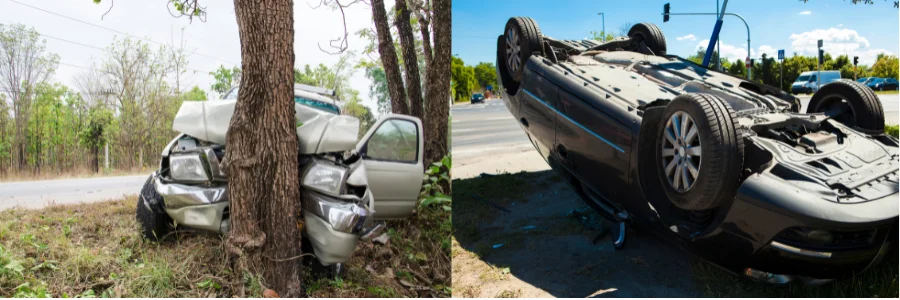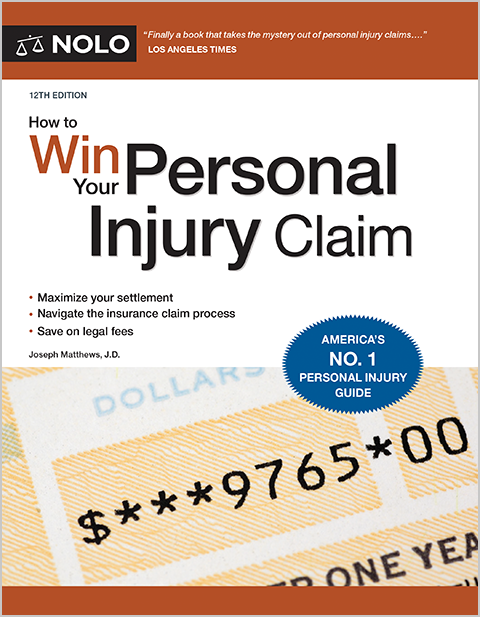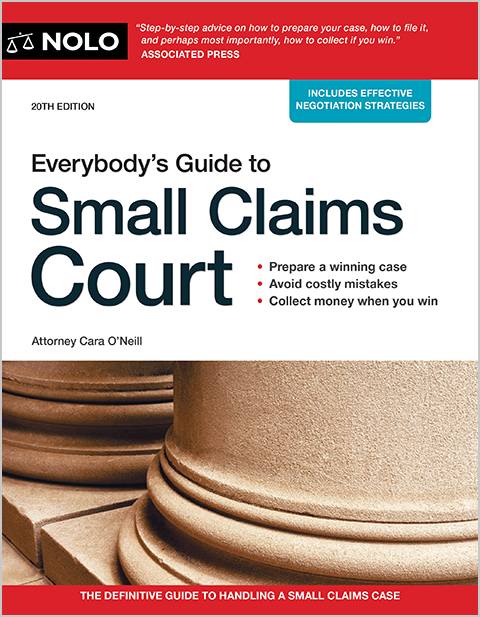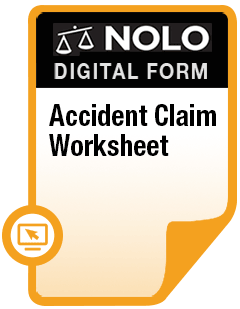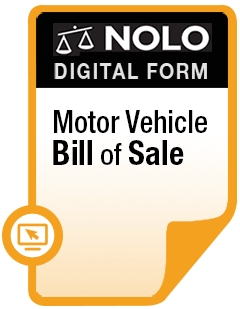Fault for a single-car accident, and the availability of insurance coverage, depends on the details of the crash.
Most traffic accidents involve two or more vehicles colliding—think rear-end and side-impact crashes, for example. But plenty of accidents involve only one vehicle. Here's what to know:
- Single vehicle crashes can result from a number of causes, including driver negligence or even recklessness.
- The driver isn't always considered at fault for a single vehicle accident.
- Disputing a fault finding can be crucial if you suffered significant injury in the accident and/or the crash caused extensive property damage.
- What Is a Single-Vehicle Accident?
- What to Do After a Single-Vehicle Accident
- Will Insurance Cover a Single-Car Accident?
- Who's At Fault For a Single Car Accident?
- Examples of When the Driver in a Single-Vehicle Accident Might Not Be Liable
- What If a Passenger Is Injured in a Single-Vehicle Accident?
- Do I Need a Lawyer's Help After a Single-Vehicle Accident?
What Is a Single-Vehicle Accident?
By definition, single-vehicle accidents involve just one car, truck, or other type of motor vehicle. Typical examples include:
- the driver hits an object on or along the side of the road (like a guardrail or a tree)
- the driver swerves to avoid another vehicle, a pedestrian, an animal, a road hazard, or something else, and runs off the road, or
- the vehicle rolls over, spins out, or leaves the road (because the driver lost control of the vehicle, or due to some other cause).
What to Do After a Single-Vehicle Accident
As with any other kind of traffic accident, the things you do in the immediate aftermath of the crash (and in the days following) will play a crucial part in any car insurance claim or lawsuit you decide to make.
If you're involved in a single-vehicle accident:
- gather evidence as soon as possible
- report the accident to your car insurance carrier (and to local law enforcement and/or other state agencies as required by your state's car accident laws)
- get contact information of any witnesses
- take pictures of the scene (and of the condition of the vehicle) as soon as possible
- see if there are any nearby businesses or residences where surveillance cameras were in use—they may have caught some or part of the accident, and
- report any roadway problem to the local governmental authority in charge of maintaining the highways and roads, especially if you think a roadway defect caused your accident.
If you think you crashed due to a vehicle defect or mechanical failure (more on this later), get the car checked out immediately. Don't drive the car away from the accident scene. Have the vehicle towed to a qualified mechanic as soon as possible, and have a thorough inspection done.
Learn more about what to do after a car accident.
Will Insurance Cover a Single-Car Accident?
The answer here is yes, car insurance can kick in to cover a driver's car accident injuries and any vehicle damage after a single-car accident. But the specifics depend on whether anyone else's fault played a part in the crash, or the driver was the only one responsible.
When Your Own Insurance Covers a Single-Vehicle Accident
If it's determined that you were to blame for your single car accident, you might still be able to make a car insurance claim, if you have certain kinds of coverage as part of your policy. For example:
- Your own personal injury protection (PIP) or medical payments ("MedPay") coverage can pay for treatment of your car accident injuries, your lost income stemming from the crash, and other out-of-pocket losses, regardless of the cause of the accident.
- Your own collision coverage would pay to get your car fixed or replaced after the crash, even if you caused it.
And beyond car insurance, don't forget that your own health insurance coverage will pay for treatment of your car accident injuries.
Of course, certain kinds of losses (or "damages") won't be recoverable under any kind of insurance policy you carry, including compensation for your non-economic losses (i.e. physical or mental pain and suffering).
Finally, note that if you're found at fault for your single-car accident and you end up making a claim under your own car insurance policy, you might see your rates go up.
When Someone Else's Car Insurance Might Cover a Single-Car Accident
When single-car accidents might involve the fault of someone other than the driver, that other party's liability insurance can kick in and cover the harm resulting from the crash.
For example, let's say Driver A tries passing Driver B in the "No Passing" zone of a two-lane highway. Driver C, approaching in the opposite direction, runs off the road rather than face a head-on collision with Driver A. In this situation, Driver A would almost certainly be found at fault, and their liability car insurance would apply to cover all of Driver C's accident-related losses, up to policy limits.
Let's take a deeper dive into the fault question.
Who's At Fault For a Single Car Accident?
Single-car accidents are no different than other traffic accidents in the sense that there's always an underlying cause. It's certainly true that the driver is often found at fault for the accident, but there are plenty of scenarios in which blame for a single-vehicle accident lies elsewhere.
Why does a fault finding matter after a car accident? If a car insurance company's investigation determines that the negligence of the driver is the sole cause of a single-vehicle accident, that driver's options for recovering anything at all are seriously limited.
For example, if the driver only has liability car insurance coverage, that kind of coverage only pays for car accident injuries and property damage incurred by others in a crash caused by the insured. It won't cover any of the driver's own injuries or vehicle damage if they're the cause of their own single-vehicle accident.
Examples of When the Driver in a Single-Vehicle Accident Might Not Be Liable
It's important to keep in mind that just because you're alone in your vehicle at the scene of your accident, that doesn't necessarily mean:
- you were the only driver (or person) involved
- yours was the only vehicle involved, or
- the accident scene tells the complete story of how your crash happened.
Let's look at a couple of examples of when a driver in a single-vehicle accident might not be negligent in connection with the crash, and therefore might avoid liability.
They Were Avoiding an Accident With a Negligent/Reckless Driver
If your single-vehicle accident was a result of you trying to avoid a more serious collision with a negligent or reckless driver, obviously the crash shouldn't be deemed your fault.
Let's say Driver A is proceeding north on a two-lane highway. Driver B is headed south. Driver A is texting, and drifts into the southbound lane. Driver B swerves to avoid a collision and ends up crashing. In this case, there was no collision, so Driver B was technically involved in a single-vehicle accident. But the accident wasn't Driver B's fault. Driver A's distracted driving was the cause of the crash.
Of course, the challenges here include identifying Driver A and finding out whether they're insured. You might be able to locate surveillance camera footage from the area to identify the driver or get the license plate number of the vehicle. Witnesses who saw what happened might also be able to help.
Bad Road Conditions Caused the Single-Vehicle Accident
If the road you were driving on was in an unsafe condition, if there was a hazard on the road that should have been removed, or if some other maintenance-related issue caused or contributed to your single-vehicle accident, you might be able to make a claim against the local municipality or other organization charged with upkeep of the roads and highways in the area.
But keep in mind that claiming that bad road conditions caused a car accident is usually an uphill battle. If the road conditions were truly that bad, then a sound counter-argument will usually be made: the driver should have been driving more slowly or carefully, given the conditions. But if the driver can make a credible argument—a huge pothole appeared out of nowhere due to known instability in that part of the roadway—there might be a chance to avoid liability for a single-car accident.
Most roadway defect claims (whether for injury or property damage) will need to be filed with the state or local government agency that's charged with maintaining the affected highway or road. These claims are subject to strict "notice" requirements and filing deadlines. Learn more about injury claims against the government in your state.
A Vehicle Defect Caused the Single-Car Accident
A driver might be able to escape liability for a single-vehicle accident if a vehicle defect or equipment failure played a part in causing the crash. The key here is that the defect or failure must be sudden and unexpected. If the vehicle was subject to a recall notice, or if a known mechanical issue was allowed to get worse, then a reasonable (non-negligent) driver would have gotten the car fixed instead of driving it around (or so the manufacturer's argument will go).
What If a Passenger Is Injured in a Single-Vehicle Accident?
Up until now we've discussed the fairly straightforward situation where the driver of a vehicle is involved in a single-car accident, focusing on the claim options available to the driver in that scenario. But what if a passenger (or multiple passengers) was riding in the vehicle at the time of the crash? The passenger's options outnumber the driver's. That's because someone is usually at fault for a single-vehicle accident, but it's never the passenger.
We've stressed that when the driver of a vehicle that's involved in a single-car accident is also the only person who's at fault for the crash, their options for getting compensation for their injuries are very limited. This is mainly because a driver's liability car insurance (which is required under most state car insurance laws) only applies to harm caused to others by the driver. But while that same liability insurance won't cover the driver (who's the policyholder), it will apply to any passenger who was riding in the vehicle and is injured in a single-vehicle crash caused by the driver.
So, depending on the state's car insurance rules and the different kinds of coverage in place, an injured passenger's options after a single-vehicle accident could include:
- an injury claim under the driver's liability car insurance
- an injury claim against another driver's liability car insurance (if another vehicle was involved in the crash)
- an injury claim under the personal injury protection (PIP) coverage of the driver whose vehicle the passenger was riding in, and
- an injury claim under the passenger's own PIP coverage (if they have it).
Learn more about passenger injury claims after a car accident.
Do I Need a Lawyer's Help After a Single-Vehicle Accident?
A single-vehicle accident can run the gamut in terms of seriousness. You might incur minor vehicle damage with no injuries, make a claim under your own collision coverage, and be done with it. A lawyer's help probably won't make much of a difference in that situation. Learn more about when it makes sense to handle your own car accident claim.
But if you've been seriously injured after a single-car accident, you might need help disputing a fault finding and building your case to prove that blame for your accident lies elsewhere. That's especially true if you think negligent roadway maintenance or a vehicle defect played a part in the accident. Having a skilled legal professional on your side can make a huge difference in those situations. Learn more about when to hire a car accident lawyer, and get tips on finding the right injury lawyer for you and your case.
- What Is a Single-Vehicle Accident?
- What to Do After a Single-Vehicle Accident
- Will Insurance Cover a Single-Car Accident?
- Who's At Fault For a Single Car Accident?
- Examples of When the Driver in a Single-Vehicle Accident Might Not Be Liable
- What If a Passenger Is Injured in a Single-Vehicle Accident?
- Do I Need a Lawyer's Help After a Single-Vehicle Accident?
